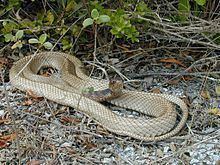Kingdom Animalia Class Reptilia Family Colubridae Genus Masticophis Order Scaled reptiles | Subphylum Vertebrata Suborder Serpentes Phylum Chordata Rank Subspecies | |
 | ||
Similar Masticophis flagellum, Masticophis, Virginia striatula, Scaled reptiles, Cemophora coccinea | ||
Eastern coachwhip snake masticophis flagellum flagellum shaw 1802
Masticophis flagellum flagellum, commonly known as the Eastern coachwhip, is a subspecies of M. flagellum, a nonvenomous, colubrid snake, endemic to the southern United States.
Contents
- Eastern coachwhip snake masticophis flagellum flagellum shaw 1802
- Eastern coachwhip snake masticophis flagellum flagellum x s two
- Distribution
- Description
- Habitat
- Behavior diet
- Reproduction
- Myth
- References
Eastern coachwhip snake masticophis flagellum flagellum x s two
Distribution
The subspecies ranges from North Carolina to Florida in the east, and from eastern Kansas to eastern Texas in the west. They are notably absent from the Mississippi Delta, which divides their range into two separate groupings.
Description
Adults are long and slender, ranging from 50 to 72 inches (130–180 cm) in total length. The longest on record was 102 inches (260 cm). They are among North America's largest native snakes. The head and neck are usually black, fading to tan posteriorly. Some specimens may lack the dark head and neck pigmentation. Their smooth scales and coloration give the appearance of a braided whip, hence the common name.
Habitat
The subspecies can be found in a wide variety of habitats, but is most abundant in the southeastern coastal plain. Its preferred habitat includes sandy pine woodlands, pine-palmetto flatwoods, cedar glades, and along creeks, marshes and swamplands.
Behavior & diet
The Eastern coachwhip is an active, fast-moving snake. It is diurnal and hunts it prey by smell and sight. It frequently hunts with its head raised above the ground and vegetation, and unlike most snakes, visually locks onto its prey's position before capture. Following capture, the snake swallows its prey alive. It has strong jaws with rows of small, inward slanting teeth. It has sometimes been observed to beat its prey against the ground in an apparent effort to stun it prior to swallowing. Prey items include birds, large insects, lizards, other snakes, and small mammals.
Reproduction
Eastern coachwhips mate in the spring, with the female laying a clutch of 10-16 eggs in June or July. The eggs are laid in rotting vegetation or logs. The hatchlings emerge after 6 to 11 weeks, and are initially 12 to 16 inches (30–41 cm) in length.
Myth
A common myth is that the Eastern coachwhip will intentionally attack people and whip them with its tail. This is false. In truth, when disturbed this snake will usually quickly flee. It will sometimes vibrate the tip of its tail among the ground litter, making a sound suggestive of a rattlesnake. If trapped, it will aggressively defend itself, striking repeatedly and biting.
